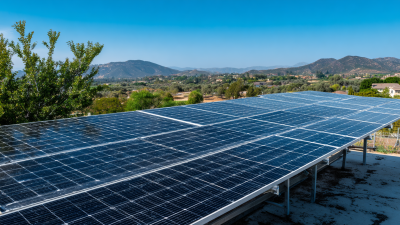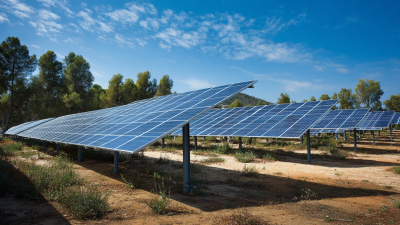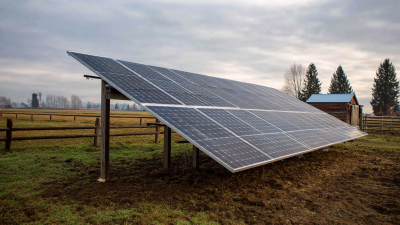Blog
How to Choose the Right Off Grid Solar System for Your Home
Choosing the right off grid solar system for your home is a crucial decision that can significantly impact your energy independence and sustainability. With the global solar market expected to reach over $223 billion by 2026, and off grid systems gaining traction due to their ability to provide power in remote locations without reliance on the traditional grid, homeowners are increasingly considering this renewable energy solution. According to a report by the International Renewable Energy Agency, the off grid solar capacity is anticipated to grow by 8% annually, reflecting a rising demand for autonomous energy systems. As the technology continues to evolve, understanding the various types of off grid solar systems available, their components, and their respective advantages is essential in making an informed choice that aligns with your specific energy needs and lifestyle.

Factors to Consider When Comparing Off Grid Solar Systems for Your Home
 When comparing off-grid solar systems for your home, several key factors should be considered to ensure you make the right choice. One of the most critical aspects is your energy consumption. Understanding how much electricity your household uses on average will help you determine the size of the solar system you need. Substantial energy use might require a larger system with more panels and batteries, while moderate consumption might be satisfied with a smaller setup.
When comparing off-grid solar systems for your home, several key factors should be considered to ensure you make the right choice. One of the most critical aspects is your energy consumption. Understanding how much electricity your household uses on average will help you determine the size of the solar system you need. Substantial energy use might require a larger system with more panels and batteries, while moderate consumption might be satisfied with a smaller setup.
Tip: Conduct a detailed energy audit of your home. List out all your appliances and their power requirements to get a clearer picture of your daily energy needs. This will guide you in determining the appropriate system capacity.
Another essential factor is the quality and efficiency of the solar panels and batteries. Different brands and types vary in efficiency ratings, which directly impacts how much energy you can generate and store. Additionally, consider the warranty and lifespan of the equipment. Investing in high-quality components may lead to lower long-term costs and better performance.
Tip: Research certifications and customer reviews for solar products. Look for panels that have high efficiency ratings and come with robust warranties to ensure durability and efficiency over time.
Efficiency Ratings: Understanding Solar Panel Performance Metrics
When selecting an off-grid solar system, one crucial aspect to consider is the efficiency rating of solar panels. These ratings, typically expressed as a percentage, indicate how effectively a solar panel converts sunlight into usable electricity. For instance, a panel with a 20% efficiency rating converts 20% of sunlight into electrical energy, while the rest is lost as heat. Higher efficiency panels may have a higher initial cost, but they can be more advantageous in terms of space and performance, especially for homeowners with limited roof area.
Understanding other performance metrics is also vital. Look into the temperature coefficient, which measures how much the panel’s efficiency drops at higher temperatures; lower coefficients are preferable. Additionally, consider the degradation rate, indicating how much efficiency a panel will lose over time. Most quality panels have a degradation rate of around 0.5% per year. By comprehensively evaluating these metrics, homeowners can make informed decisions that align with their energy needs and budget while ensuring they get the best performance from their off-grid solar system.
How to Choose the Right Off Grid Solar System for Your Home - Efficiency Ratings: Understanding Solar Panel Performance Metrics
| Solar Panel Type | Efficiency Rating (%) | Power Output (Watt) | Temperature Coefficient (°C) | Warranty (Years) |
|---|---|---|---|---|
| Monocrystalline | 20-22 | 300-400 | -0.3% / °C | 25 |
| Polycrystalline | 15-20 | 250-350 | -0.5% / °C | 20 |
| Thin-Film | 10-12 | 100-200 | -0.2% / °C | 10 |
| Bifacial | 18-23 | 350-450 | -0.3% / °C | 30 |
Battery Storage Solutions: Analyzing Capacity and Lifespan for Off Grid Systems
When selecting a battery storage solution for off-grid solar systems, understanding both capacity and lifespan is crucial. The capacity of a battery, measured in kilowatt-hours (kWh), determines how much energy it can store. According to the National Renewable Energy Laboratory (NREL), an average household typically requires between 20 kWh to 30 kWh per day, meaning that choosing batteries that can collectively match or exceed this daily consumption is essential for uninterrupted power supply.
Tips: Always consider future energy needs as well. If you plan to expand your off-grid system or add more appliances, opt for batteries with higher capacities to accommodate that growth.
Lifespan is another critical factor, often expressed in terms of cycle life – the number of charge and discharge cycles a battery can endure before its capacity significantly diminishes. Lithium-ion batteries, for instance, tend to provide around 3,000 to 5,000 cycles, translating to about 10 to 15 years of effective use. In contrast, lead-acid batteries typically offer around 500 to 1,200 cycles. Therefore, selecting a battery with adequate cycle longevity can drastically impact long-term costs and reliability.
Tips: Regular maintenance can extend battery lifespan, so it's wise to keep an eye on battery health and performance to maximize your investment.
Battery Storage Capacity and Lifespan for Off Grid Solar Systems
Cost-Benefit Analysis: Evaluating Initial Investment vs. Long-Term Savings
When considering an off-grid solar system for your home, a critical aspect to evaluate is the cost-benefit analysis, particularly the balance between initial investment and long-term savings. The upfront costs for installing a solar system can be significant, encompassing equipment, installation, and potential permits. However, understanding the long-term financial benefits can greatly enhance the decision-making process. Over time, savings on utility bills can offset these initial expenses, especially in regions where electricity prices are high.
Moreover, the longevity and low maintenance nature of solar systems generally contribute to sustained savings over their operational lifetime, often exceeding 25 years. It's essential to factor in additional variables, such as potential tax incentives, rebates, and the decreasing costs of solar technology, which can further enhance the return on investment. By meticulously assessing the costs involved against the savings generated over the years, homeowners can make informed decisions that align with both their financial goals and sustainability objectives.
System Compatibility: Ensuring Your Off Grid Setup Meets Energy Needs and Regulations
When selecting an off-grid solar system, understanding system compatibility is crucial to ensure it meets your energy needs and complies with local regulations. According to the National Renewable Energy Laboratory (NREL), residential solar energy systems can be categorized into different configurations based on energy consumption patterns and regional solar exposure. A detailed energy audit is essential; it helps determine your household’s energy usage, which typically averages around 800 kWh per month for a U.S. household. Choosing a system that matches this demand while allowing for future energy needs is vital.

In addition to energy demands, compliance with local regulations plays a significant role in your off-grid setup's success. The Solar Energy Industries Association (SEIA) recommends checking local zoning laws, electrical codes, and permit requirements before installation. For instance, certain areas may mandate specific types of batteries or inverters for safety and efficiency. Furthermore, incorporating renewable energy credits or incentives can not only make your project financially viable but also ensure it aligns with sustainable practices mandated by local legislation. Understanding these compatibility factors will lead to a more effective and legally compliant off-grid solar system for your home.





